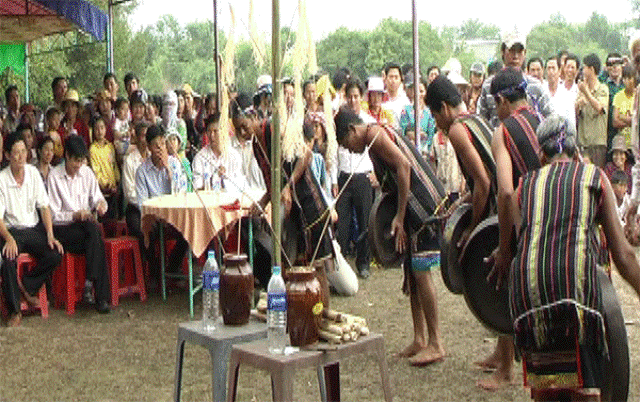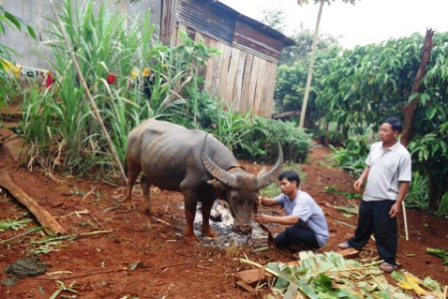 A ritual in Stieng wedding custom of "repaying duty". A ritual in Stieng wedding custom of "repaying duty".
|
Stieng boys and girls get to know each other at community events such as festivals and weddings. When they decide to get married, they inform their families and the boy’s family sends two matchmakers to the girl’s house to make a proposal. Patriarch Dieu Do said: “The boy’s family prepares proposal presents according to Stieng tradition. These must include a silver bracelet and necklace.”
Patriarch Dieu Do said in the past the presents the girl’s family asked for were equivalent to what the girl’s father gave to marry her mother. The girl’s father tells the matchmaker the required number of buffalos, cows, pigs, and vases of wine. Customarily, if the bridegroom’s family is able to provide all the requested presents, he could take the girl to his house or the couple could live on their own house. Otherwise, the bridegroom had to live with the bride’s family until he could give them all of the presents. That’s the “repaying duty”. The presents must include a javelin, a symbol of power.
 A buffalo is part of the wedding present. A buffalo is part of the wedding present.
|
Dieu Thi Kia said: “The presents must include a javelin, a popular item at any festival of the Stieng, such as the buffalo sacrifice festival. The wedding presents must include a javelin to ensure a good marriage.”
In the past, the wedding ceremony could be held one or two years after the proposal ceremony. During that time, the couple didn’t live together but worked together in the field and helped each other when one was sick.
Now the wedding protocol has been simplified. The “repaying duty” no longer exists and the wedding ceremony is typically held just a few days after the proposal ceremony. The bridegroom’s family gives the bride earrings, brocade dresses, and necklaces. The bride gives her husband’s relatives some brocade fabric. Relatives and neighbours are invited to the wedding party to feast on chicken, pork, buffalo meat, and wine.
Dieu Thi Kia again: “Relatives of both families are invited to the party. When they leave the party, they are given some food to take home. It demonstrates unity to share even little food.”
The couple live with the wife’s family for the first week. The next week, the husband takes his wife to his house to introduce her to the house’s genies.
The Stieng consider a wedding to be a happy event, not just for the two families, but for the whole community.